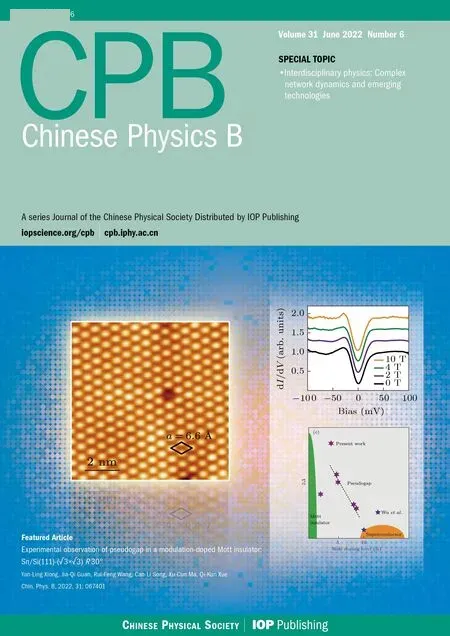Short-wave infrared continuous-variable quantum key distribution over satellite-to-submarine channels
Qingquan Peng(彭清泉) Qin Liao(廖骎) Hai Zhong(鐘海) Junkai Hu(胡峻凱) and Ying Guo(郭迎)
1School of Automation,Central South University,Changsha 410083,China
2College of Computer Science and Electronic Engineering,Hunan University,Changsha 410082,China
3School of Computer Science,Beijing University of Posts and Telecommunications,Beijing 100876,China
Keywords: continuous-variable quantum key distribution (CVQKD), short-wave infrared, satellite-tosubmarine
1. Introduction
Continuous-variable quantum key distribution(CVQKD)system is one of means of quantum information processing which allows remote participants to share a secret key through an untrusted channel.[1–4]In the traditional CVQKD system,the transmitter Alice encodes the information in the quadrature of the optical field, whereas the receiver Bob decodes the received quantum pulse by using coherence detection. Recently,it has become a hot spot of optical communication technology due to its low cost and high reliability.
With the increasing enhancement of the free-space optical communications, we begin to pay an attention to the security of marine-enabled information for the CVQKD system. Unlike the fiber optic network, the light diffusion effect of quantum pulse transmission in free-space channel is more obvious, and the more interference it receives. Currently, the CVQKD system has been proven to achieve the good performance in free-space channels, such as 500 km in pure atmospheric channel[5]and 50 m in pure seawater channels.[6]However, there is a lack of systematic research in more complex trans-media application scenarios, such as satellite-to-submarine communication. In our previous study,we split the satellite to submarine channel in two through a third party, allowing quantum pulses to be transmitted in two separate channels.[7–9]It is worth noting that the addition of a third party will undoubtedly increase the complexity of the system, which will pose a threat to the stability of the satellite-to-submarine CVQKD scheme. In addition,from the perspective of confidentiality, the existence of a third party is likely to reveal the physical location of the submarine. Therefore, it is necessary for us to study point-to-point satellite-tosubmarine quantum communication. There are many difficulties in point-to-point optical communication in free space. For example,due to the light diffusion effect,[10]we must increase the receiving area at destination to obtain the more quantum pulse signals, while ensuring that the receiving area should be made small enough to minimize the transmission of skynoise photons. The choice of receiving area size is closely tied to the choice of quantum pulse wavelength, making the wavelength the most important and critical part of the practical system.[11–13]
In previous experimental implementations, the 1500-to-1600-nm light is usually regarded as an ideal quantum pulse carrier in the atmospheric channel due to compatibility with current telecom technology,the wavelength-dependent nature of scattering, and lower solar radiance.[14–17]However, the underwater transmission of 1500-to-1600-nm light tends to suffer from severe attenuation, which inevitably deteriorates the security of the satellite-to-submarine system. Therefore,we need to study the parameters of the atmosphere, sea surface,and sea water channel,and establish a complete satellitesubmarine quantum channel model.
To demonstrate the wavelength dependence of satelliteto-submarine quantum communication, we estimate the parameters of the trans-media channels, involving the daytime atmosphere,sea surface and seawater,and find that the shortwave infrared performs well in the above-mentioned channels, which corresponds to the wavelength range of 400–500 nm.[18,19]For more challenging free-space channels, we employ the aggressive spectral filtering techniques(high-order adaptive optics, AO) that allow the use of very tight spatial filtering and relax other filtering requirements.[20,21]In order to evaluate the feasibility of satellite-to-submarine CVKQD,we consider the secret key rate as the performance metric.Through numerical simulation analysis,we find that the satellite can share a string of security keys with submarine with a depth of less than 45 m at an altitude of 60 km.The results will contribute to the development of satellite-to-submarine quantum communication and global quantum networks.
This paper is organized as follows. In Section 2 we suggest the structure of the satellite-to-submarine CVQKD system,which involves the atmospheric,seawater and sea surface channels separately. We demonstrate that shorter wavelengths can be used for satellite-to-submarine quantum communications over trans-media channels. In Section 3 we show the security analysis. Finally,a conclusion is drawn in Section 4.
2. Wavelength optimized CVQKD
The implementation challenges of satellite-to-submarine quantum communications are channel complexity, high optical noise interference and the uncertainty of the environment.The scheme of the satellite-to-submarine-involved CVQKD is shown in Fig.1,where Alice(satellite)modulates a quantum pulse over a Gaussian state via electro-optical modulators and sends it to Bob (submarine). The quantum pulse has to pass through a turbulent atmosphere, roughness of the sea surface and high-loss seawater before arriving at Bob. Here the atmospheric channel is further divided into a medium Earth orbit (MEO) layer, a low Earth orbit (LEO) layer and a general airspace layer. After receiving the quantum pulse, Bob needs to use adaptive optics to correct the received quantum signals. In what follows, quantum pulses are detected using a local laser generated by a local oscillator(LO)for coherent measurements.[22–24]

Fig.1. Short-wave infrared CVQKD over satellite-to-submarine link. (a)Overview of the satellite-to-submarine CVQKD.The link is characterized by actual atmospheric, sea surface and seawater channel. (b)The scheme of short-wave infrared CVQKD over satellite-to-submarine link.The quantum pulses prepared by Alice transmitted through the atmosphere,sea surface and seawater.(c)Bob uses local oscillation for homodyne detection. AM:amplitude modulator;PM:phase modulator;PIN:p–i–n photodiode;ηngp: transmittance of non-Gaussian operations beam splitter;Att.: attenuator;LO:local oscillator;BS:beam splitter.
For the practical implementations,it is necessary to consider the stability and penetration of the quantum pulse itself,as well as the correction of the quantum pulse that can be made using AO technology.We note that the choice of optical wavelength is an indispensable part of laser generation of quantum pulses. In addition,the transmission performance of different light wavelengths is also worth studying.
2.1. Atmospheric turbulence effect
In Fig.2(a),it illustrates effect of atmospheric turbulence on quantum pulse. The aberrated wavefront results in a narrower diffraction-limited spot (DL spot) than the turbulencelimited spot (TL spot). We note that Bob receives not only quantum pulses, but also sky-noise photons. Therefore, the receiving area of Bob cannot be too small to lose part of the quantum pulse, nor too large to introduce too many skynoise photons. In particular, we make use of an AO technique that not only corrects atmospheric turbulence, but also works within the diffraction limit of optical receivers. The AO technique is necessary for performance improvement of the CVQKD system in which narrows spectral filtering will block distorted quantum pulses, and hence enhances the mixing efficiency of homodyne detection. We suggest an LEO satellite downlink structure with the parameters given byDT=10 cm transmitter,DR=100 cm receiver,spectral filter efficiencyηspec=0.9 and reception efficiencyηrec=0.5. The detection efficiency isηdet=0.8 for all wavelengths, the initial excess noise isε0=0.01,and reconciliation efficiency isβ=0.85.
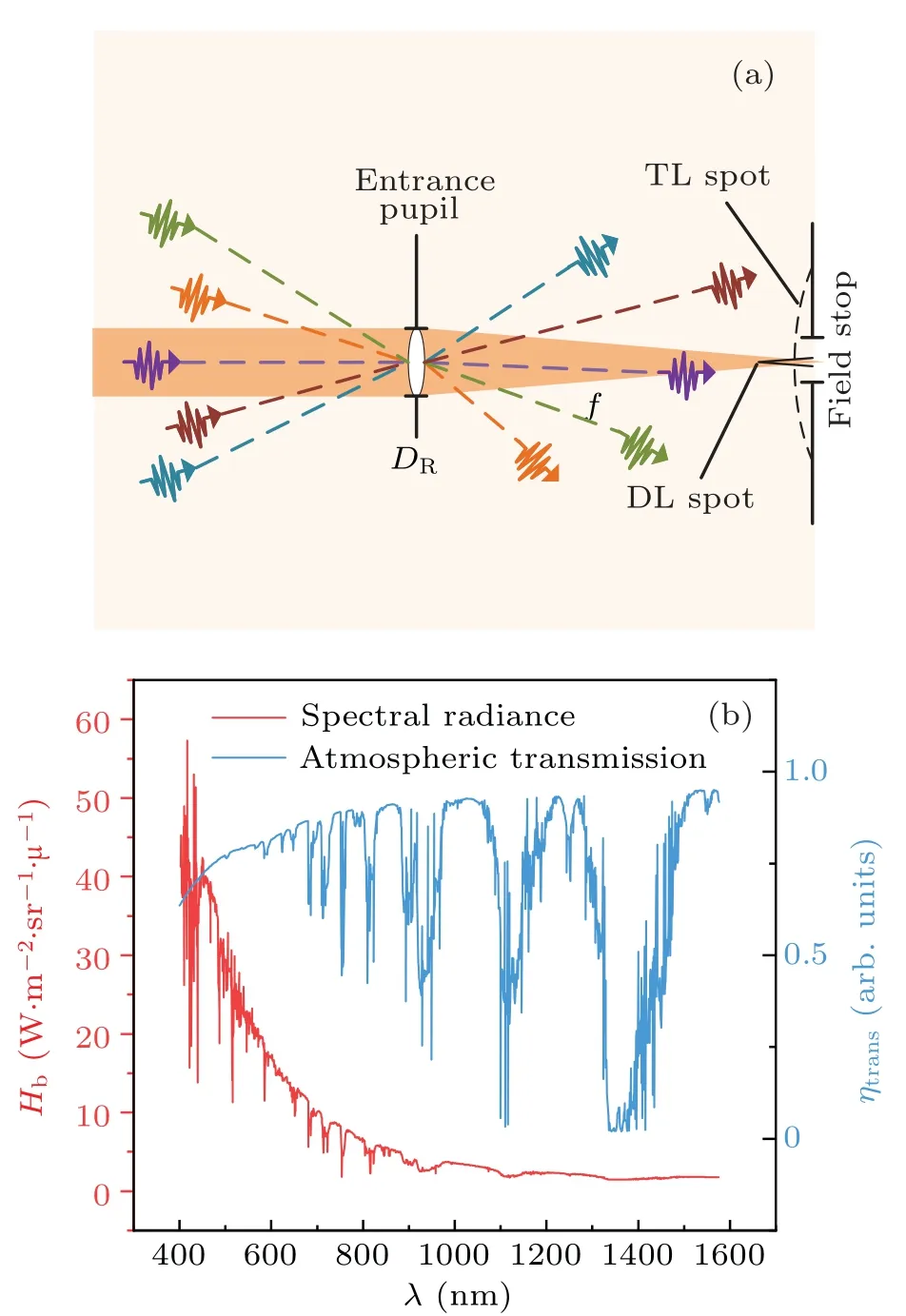
Fig.2. (a)The filtering process of sky-noise photons in the atmospheric environment and the focusing characteristics in the presence of turbulence are described, where red, orange, blue, green and violet colors correspond to wavelengths of light, respectively. DR is the receiver aperture diameter and f is the receiver focal length. (b) Atmospheric transmission and spectral radiance of receiver pointed to the zenith at 1:00 PM on the winter solstice at 50 km,where the red line represents the spectral radiance Hb and the blue line represents the atmospheric transmittance ηtans.
In a practical atmospheric environment, we can have ground receiver looking to different points in the sky at different solar positions to obtain different site-dependent downlink scenes for spectral radiance profiles and wavelength dependent transmission.As shown in Fig.2(b),the atmospheric transmittance and spectral radiance of the zenith receiver at 1:00 PM on the winter solstice with 50 km visibility can be achieved.[25]Considering that wavelength optimization is a key in performance improvement of the satellite-to-submarine communications, the whole spectral structure, in the system design analysis,should include the seawater wavelength range. Although the experimental data demonstrate relatively constant spectral radiance near the wavelength 1550 nm, we choose the wavelength of nearly 400–700 nm for the performance analysis.
The performance of CVQKD is determined by the number of effective quantum pulses received. For a receiver operated at the DL without central obscuration, the field stop can be set to transmit the central peak of the DL Airy pattern to achieve transmitting of 84%of the quantum pulse. The spatial filter diameter is given by


In Fig.3(a),we show the atmospheric channel efficiency in the optical wavelength range of 400–1600 nm based on the data in Fig. 2(b). The black curve indicates the TL strategy and the red curve indicates the DL strategy. We find that the optical wavelength illustrates a high channel efficiency in the range of 400–700 nm and exhibits a stable upward trend. This result overturns our previous perception that 1550 nm is the best wavelength for atmospheric transmission. It makes possible to establish the practical CVQKD system between satellite and submarine.
2.2. Seawater effect
Similar to the atmospheric channel,the underwater channel is subject to scattering and absorption,as well as attenuation due to beam degradation and drift caused by turbulence.Figure 3(b)shows the effect of the minimum absorption coefficientawof pure water on the light beam.[19]We find that the absorption coefficient of light from the underwater channel is related to the light wavelength and the minimum absorption coefficient is obtained in the light wavelength range of 400–500 nm.
The seawater can be seen as pure water with impurities,which includes chlorophyll-a concentration, xanthic/humic acid and particles that can affect quantum pulse transmission and bring about signal loss.[28]It can be modeled by depthd, chlorophyll-a concentration to obtain the concentration of particles[29]
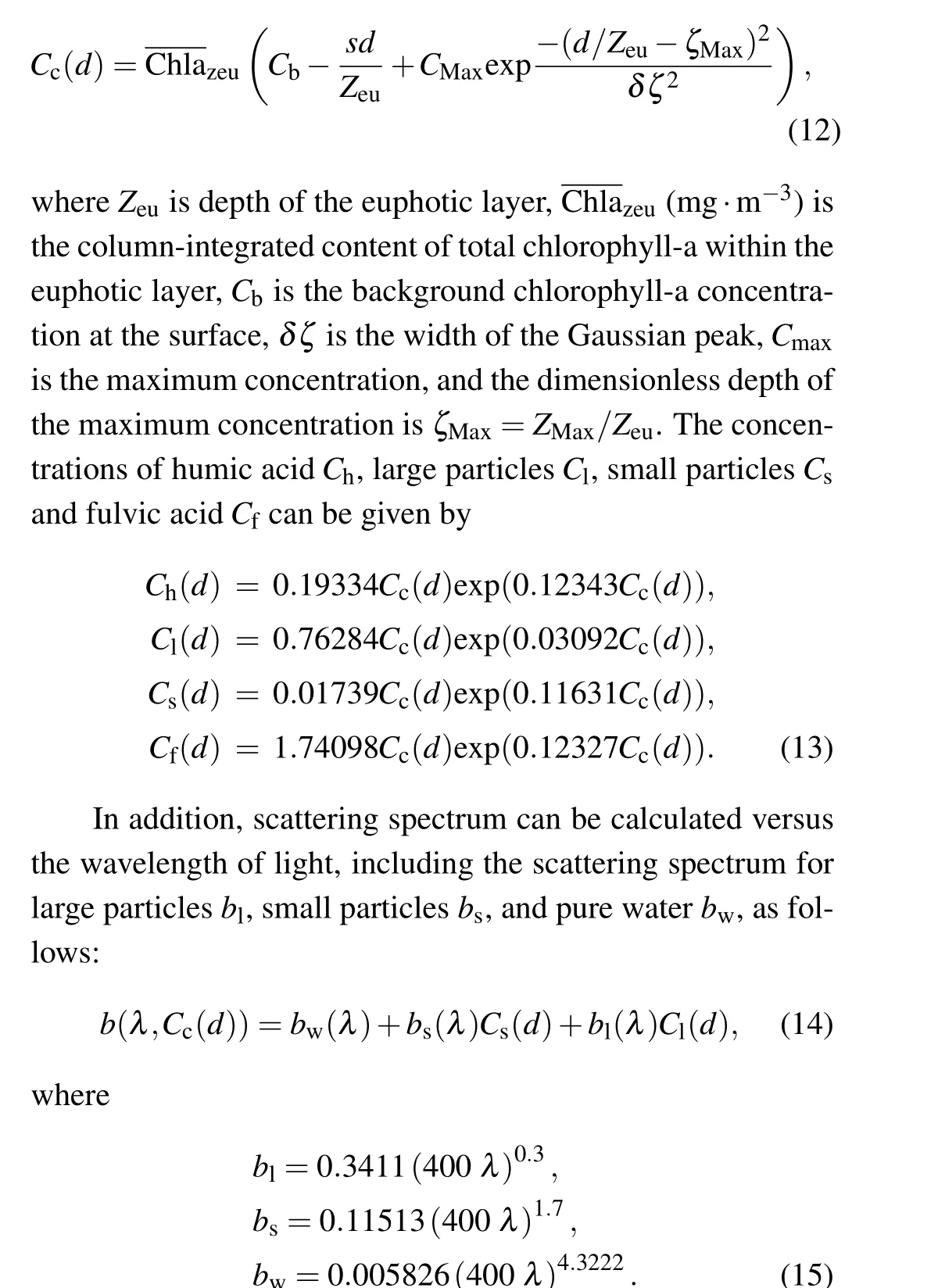
Here we have the specific absorption coefficientsaf=35.959 m2/mg, humic acidkf= 0.0189 nm-1, exponential coefficient for the fulvic acidah= 18828 m2/mg, concentration factor of particlesac= 0.056, and chlorophyllkh=0.01105 nm-1.[30]The absorption spectrum can be similarly given by

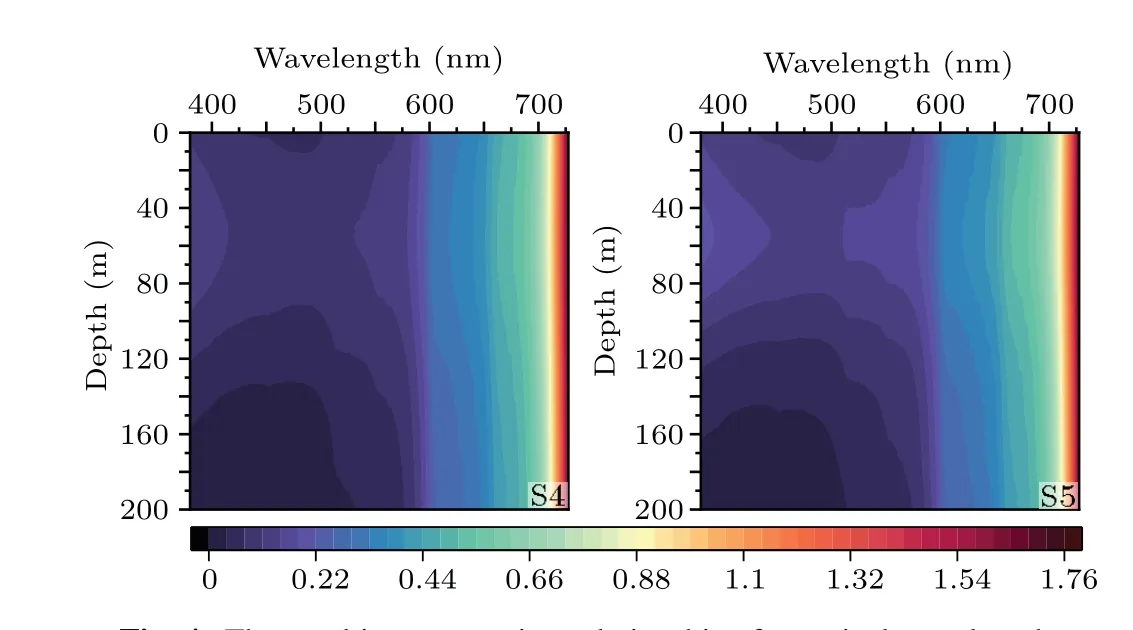
Fig. 4. The resulting attenuation relationships for optical wavelengths and depths.
The attenuation relationships of wavelengths and depths are shown in Fig.4, where the left figure is the simulation of data S4 and the right figure is the simulation of data S5. Taking the depth into account, we have four layers, i.e., surface layer 0–100 m depth,upper waters ranging 100–120 m depth,intermediate layer 120–160 m, and deep water layer below 160 m, because the surface layer is well mixed with waves,currents and tides. However,as the depth increases,the water temperature decreases, the density increases, and the salinity increases,making it difficult to transmit quantum pulses. The result shows that the attenuation coefficient increases with increasing depth, in which the surface layer performs the best and the deep water layer gets the peak attenuation. From the point of view of light wavelength, we have four regions, i.e.,purple region 400–550 nm,blue region 600–650 nm,green region 600–700 nm, red region above 700 nm. The shorter the wavelength, the higher the energy it possesses and the more suitable it is for transmission in seawater. The result shows that as the light wavelength increases, the attenuation coefficient also increases, where the purple region has the best performance, while the red region gets the attenuation peak.Consequently,in the surface layer of seawater,the use of 400–500 nm region wavelengths is more suitable for satellite-tosubmarine quantum communications.
2.3. Sea surface effect
The sea surface,which causes refraction and deflection of quantum signals,has an effect on performance of the satelliteto-submarine quantum communications. We consider the effect of the sea surface on the transmitted quantum signals when taking into account zenith angles. The generic wind and wave model is used for our security analysis.[31]It suggests an approach to explain the statistics of the Sun’s glitter on the sea surface based on the statistics of slope distribution. We find that the probability distribution of the cross wind slope component is close to a Gaussian distribution,while the probability distribution of the upwind slope component needs to be approximated by some additional higher order moments.Therefore,the Gram–Charlier distribution can be used to represent the statistical characteristics of the sea surface slope. It can be expressed as follows:

Here,the parameterεudenotes the upwind with variancesσu,εccorresponds to the upwind with variancesσc, andvis the wind speed.
In Fig. 5, we show the effect of light propagation on refraction and deflection,which is based on the geometric model of the sea level.[32]We can achieve a circular orbit when taking the height of the satellite into account and the position of the zenith angle. Therefore,the received quantum pulses may be distributed around a circle.The variation of the propagation direction of the quantum pulses across the sea surface is determined by the angle of incidenceθiand the refractive index of air and water. Among them, the parameterθican be determined by the local surface slopeθ2ε=ε2u+ε2cin the directionθs=arctan(εc/εu)against the upwind direction and the zenith angleθξ. Then,the refractive indexθris calculated according to Snell’s law and expressed asθr=arcsin(sinθina/nw),wherena=1.000293 is the refractive index of air andnw=1.34 is the refractive index of water.
In Fig.6,we illustrate the light intensity distribution with changing time propagation direction for the depths of 10, 30 and 50 m. The first column plot indicates that the beam spot at the receiving surface becomes larger as the water depth increases. Compared with the first and second column plots,we find that for the given depth and zenith angle, the higher the wind speed,the larger the receiving surface beam spot becomes. Compared with the plots in the first and third columns,the concentrated distribution of light intensity gradually expands to a ring as the zenith angle increases.

Fig. 5. Geometric model diagram of water surface interference with quantum pulses. The zenith angle of the satellite is represented by θξ;θε corresponds to the slope of the waves, and θi and θr represent the angle of incidence and refraction of light,respectively.

Fig.6. The light intensity distribution with changing time propagation direction at water depths of 10 m,30 m and 50 m. The total number of photons for each case in the Monte Carlo simulation is 106.
In order to show the effect of the sea surface on the transmittance, it can be obtained by the light deflection efficiencyηdefand the fraction of transmitted incident lightηref. The parameterηdefcan be obtained by integrating the received photons.[33]The parameterηrefcan be divided into two components,which involves perpendicular

The total Fresnel[34]transmittance is calculated as

Then, the total transmittance of the surface can be derived asηsur=ηdef×ηref. After that, we have the probability distributions of light transmittance when passing through the sea surface at different wind speeds for zenith angles of 0°, 20°and 30°, as shown in Fig. 7. It is obvious that the transmittance distribution is mainly distributed between 0.97 and 0.99.With the decreasing angle of the zenith angle, the transmittance starts to focus around 0.797. Compared with the zenith angle,the wind speed has little effect on the transmittance distribution.

Fig.7. The light transmittance when passing through the sea surface at different wind speeds for zenith angles of 0°,20° and 30°. The total number of photons for each case in the Monte Carlo simulation is 106.
3. Performance analysis and discussion
3.1. Security analysis
For the security analysis of the satellite-to-submarine CVQKD system,we consider a traditional model of CVQKD with Gaussian modulations,where Alice modulates the initial state with the variance ofVA. One half of the state is measured and the other half is transmitted through the atmosphere,sea surface, and seawater in turn, with the total excess noise caused by the background light denoted byχ. Bob measures amplitude or phase quadrature with homodyne detection. We note that the transmittances of the atmosphere,sea surface and seawater fluctuate with time.[35,36]
After being propagated through the fluctuating channel,the overall state degenerates into a non-Gaussian mixed state,so the Wigner function of the overall state is the sum of the Wigner functions of the states weighted by the sub-channel probabilities. Ultimately, the covariance matrix of the mixed state is obtained by means of the transmittance and the mean value of the square root of the transmittance,i.e.,


It shows that Alice’s modulation varianceVAplays an important role in performance of the system.
In Fig.8(a),it illustrates the relationship between modulation varianceVAand secret key rate. The results show that as the depth of Bob increases, the effect ofVAon the secret key rate is weakened and the desirable range is extended. For the given depth, water quality of S4 is more sensitive toVAcompared with water quality of S5. In order to obtain the best value ofVA,we performed the same simulation experiment in two different water qualities. In the first scenario, Bob is located in the S4 water environment. As shown in Fig.8(a),the solid lines with red, yellow, and blue represent the underwater transmission distances 10 m,20 m,and 30 m,respectively.We find that the secret key rate shows a trend of increasing,stabilizing, and decreasing as theVAincreases. We also find that the red solid line can obtain the maximum secure key rate aroundVA=2.09, the yellow solid line can obtain the maximum secure key rate aroundVA=2.01,and the blue solid line can obtain the maximum secure key rate aroundVA=1.98.Therefore, we combine the results of the three dashed lines and consider that the best value range ofVAis 2. In the second scenario, Bob is located in the S5 water quality. Dashed lines in Fig. 8(a) with orange, green, and blue represent the underwater transmission distance is 10 m, 20 m, and 30 m,respectively. Based on the same rule,we believe that the best value range ofVAis 2. Another factor that cannot be neglected in the satellite-to-submarine CVQKD system is the sea surface. If the sea surface conditions are poor,it will result in the transmitted quantum pulse not being well received but being deflected out of the receiving hole,which can be described by using the parameterηdef. In Fig.8(b),it shows the TL strategy of the secret key rate generation performance. We find that the secret key rate decreases as wind speed increases. Therefore, in order to ensure the proper operation of the satelliteto-submarine CVQKD system,Alice and Bob need to monitor the weather conditions to establish the secret keys.

Fig. 8. (a) The secret key rate as a function of different water quality,underwater transmission distance, and modulation variance VA. Other parameters are set to the winter solstice with high visibility (50 km),the wavelength is 500 nm,and the TL strategy. (b)The secret key rate versus wind speed(3 m/s,6 m/s,9 m/s,and 12 m/s)and depths(10 m,20 m,30 m,40 m,50 m,60 m and 70 m). The number of photons used for Monte Carlo simulations is 106 for each case.
In Section 2, we focus on characteristics in the presence of turbulence in the atmospheric channel and suggest the TD and DL strategies based on two spatial filtering strategies.These two strategies have effect on the secret key rate of the satellite-to-submarine CVQKD system. As shown in Fig. 9,we obtain simulations of the DL strategy and the TL strategy.In both strategies we consider the performance of the system in the flat sea surface case,i.e.,wind speed 3 m/s and deflection efficiencyηdef=1. Comparing the TL strategy and the DL strategy,we find that the overall performance of the TL strategy is better than that of the DL strategy,e.g.,the TL strategy always obtains a higher secret key rate for the given depth.The simulation results also show that homodyne detection can obtain a higher secret key rate compared with heterodyne detection. It is noteworthy that the secret keys can be successfully established at an altitude of 600 km even in the daytime. In addition,the secret key rate decreases as the depth of Bob increases. The reason is that the transmittance of seawater tends to decrease with increasing depth.
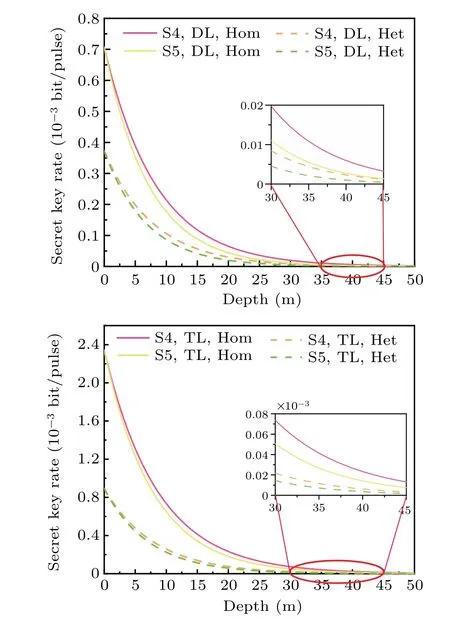
Fig. 9. Simulation diagram of the secret key rate of satellite-tosubmarine CVQKD for winter solstice points to the zenith at 1:00 PM and the visibility is 50 km.Het:heterodyne detection;Hom:homodyne detection;wind speed: 3 m/s.
3.2. Photon-catalysis-enabled performance improvement
The security analysis shows that implementing satelliteto-submarine quantum communication with short-wave infrared is feasible. However, the complexity of the freespace channel unavoidably destroys the robustness of quantum pulse, which limits its transmission efficiency. Fortunately,we may enhance quantum pulses with non-Gaussian operations (NGO), such as photon subtraction (PS)[37]photon addition (PA)[38]and quantum catalysis (QC).[39]As shown in Fig.1(b),the above operations can be realized with an asymmetrical beam splitter and photon number detector. The case form=nmeans the QC operation,while the cases form >nandm <nare the PA operation and PS operation, respectively. Here, we make use of a QC to regulate potentially deteriorated quantum pulses and thus improve transmission efficiency. In this scheme, the QC-assisted attenuation is a zero-energy-input noiseless attenuation that does not require external energy.[40]So far, the QC operation has been successfully used for improving the performance of the CVQKD system.[39,41]However, there is no implementation of QC in the satellite-to-submarine scene.
We consider the zero-photon catalysis (ZPC), where a vacuum state|0〉〈0| in auxiliary mode C is injected into the asymmetrical BS with transmittanceηQCand simultaneously detected at the corresponding output port of BS.It can be expressed as an equivalent operation given by
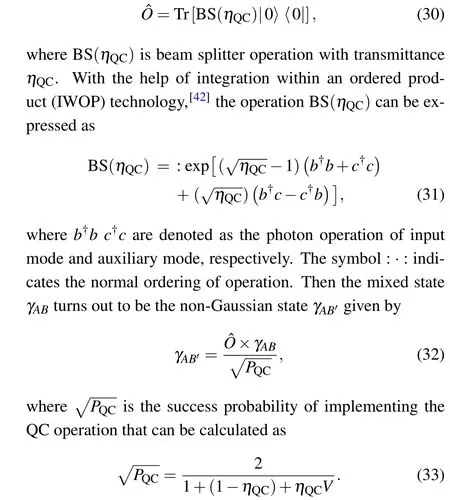
In Fig.10(a),we illustrate the secret key rate of the QCenabled CVQKD system with TL strategy. The results are obtained by performing the optimalηQCfor the given maximal transmission distance. The numerical simulations show that the QC-assisted attenuation improves the secret key rate compared with the traditional one. In Fig.10(b),we find that the ZPC performs best for performance improvement of the satellite-to-submarine quantum system in terms of both secret key rate and transmission distance. In addition, the singlephoton subtraction performs better than the single-photon addition at the long distance,but the opposite is true at the short distance.
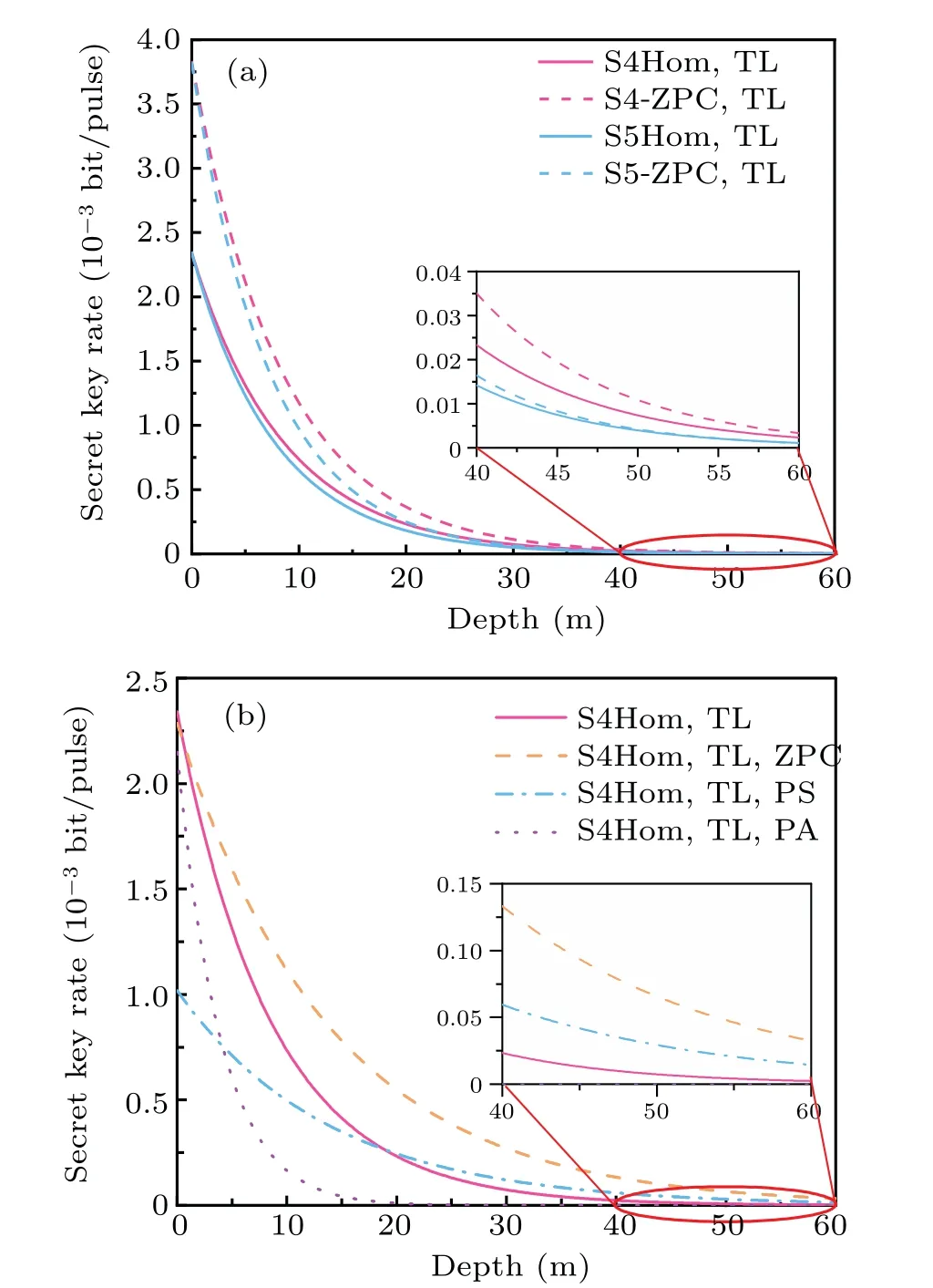
Fig.10.(a)Simulation diagram of the secret key rate of the QC-enabled satellite-to-submarine CVQKD under TL strategy for winter solstice points to the zenith at 1:00 PM and the visibility is 50 km. (b) Simulation diagram of the secret key rate of the NGO-based satellite-tosubmarine CVQKD system with TL strategy. Het: heterodyne detection;Hom: homodyne detection;wind speed: 3 m/s.
4. Conclusion
We have suggested an approach for implementations of the short-wave infrared CVQKD to overcome backgroundradiation constraints of satellite-to-submarine quantum communications. The atmospheric channel transmittance of the short-wave infrared can be estimated for the quantum pulse which can be transmitted over the satellite-to-submarine channels involving atmospheric, sea surface and seawater. We establish the satellite-to-submarine channel models focusing on atmosphere,sea surface and seawater transmittance. Accounting for these models, we derive the average transmittance in terms of not only zenith angles and wind speed,but also water quality. The results illustrate that it can overcome the satelliteto-submarine channels and achieve effective secret key even for satellite at 600-km orbit and submarine at 60 m depth. In addition, we show effects of non-Gaussian operations on the secret key rate under several strategies, i.e., QC, PA and PS.Most of the parameters are derived from existing experiments,which makes it feasible for the future deployment of a secure global satellite-to-submarine quantum networks.
Acknowledgements
This work was supported by the National Natural Science Foundation of China (Grant Nos. 62101180 and 61871407),the Key R&D Program of Hunan Province(Grant No.2022GK2016),the State Key Laboratory of High Performance Computing, National University of Defense Technology (Grant No. 202101-25), and the Fundamental Research Funds for the Central Universities(Grant No.531118010371).
- Chinese Physics B的其它文章
- Switchable terahertz polarization converter based on VO2 metamaterial
- Data-driven parity-time-symmetric vector rogue wave solutions of multi-component nonlinear Schr¨odinger equation
- Neutron activation cross section data library
- Multi-phase field simulation of competitive grain growth for directional solidification
- A novel similarity measure for mining missing links in long-path networks
- Effects of electrical stress on the characteristics and defect behaviors in GaN-based near-ultraviolet light emitting diodes

